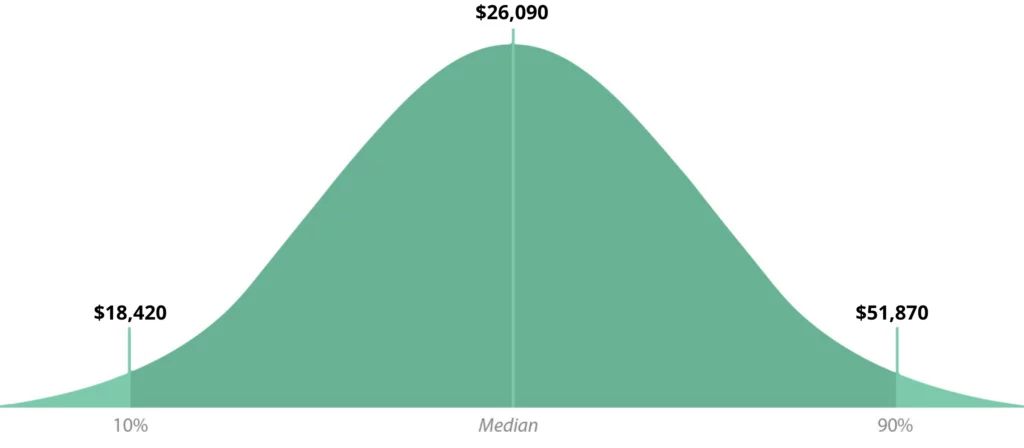
1. Overview: Job Responsibilities, Salary, and Common Requirements
2. A Comprehensive Guide to Becoming a Hairdresser
3. What Does a Hairdresser Do?
4. Signs You Should Consider Becoming a Hairdresser
5. How Do You Become a Hairdresser?
6. What are the Knowledge and Skills Needed to be a Hairdresser?
7. Popular Schools and Colleges in the U.S. for Aspiring Hairdressers
8. How to Get a Job as a Hairdresser
9. Learn About Geographic and Location Pay Differentials
10. Make Your Resume Stand Out
Hairdressers made a median salary of $26,090 in 2019. The best-paid 10 percent earned $51,870 that year, while the lowest-paid 10 percent earned $18,420.

Manicurists and Pedicurists
Skincare Specialists
Hair Stylist
Esthetician
Electrologist
Laser Technician
Barber
Cosmetologist
Beauty Therapist
Attention to detail
Communication skills
Interpersonal skills
Physical stamina
Creativity
A hairdresser, also referred to as hairstylist, is a person who specializes in cutting, styling, and coloring hair to enhance or maintain a person’s appearance. This career can either be for males or females, although barbers are considered to be for most males. They can also work for a salon or work independently.
A hairdresser has an important role in society. If you are thinking of pursuing a career as a hairdresser, here are the top reasons why you should become one.
Some careers are financially rewarding but do not draw emotional satisfaction. Becoming a hairdresser means you have an opportunity to touch and change the lives of your customers. By making them feel and look good, you are able to change their social life, shape their personality, and give them confidence.
Some clients have their own preferred hairstyles. But there are also some who would ask for your advice and trust your talent in changing their hairstyles that best suit their face shapes, hair texture, skin tone, eye color, and other factors to consider in hairstyling.
A hairdresser’s job is one of the most sociable careers out there. A lot of people go to a hairdresser to have their hair cut and styled, and of course, to have a nice chat with the hairdresser. Making new friends is one of the advantages that you will enjoy if you pursue this career.
Becoming a hairdresser is one of the most secure jobs. People will still need a haircut even in tough economic times. As long as you continue your education and learn the latest trends and techniques in hairdressing, you will never be short of work.
You can work as a freelancer and enjoy the opportunity of being flexible. You can choose to work at a different hour or a different day, whatever suits you. You can also opt to work from home or go to your client’s house if you don’t mind traveling.
In the U.S., hairdressing is expected to grow faster than the average occupation, at 4%, with a median salary of $26,090 per year (according to the U.S. Bureau of Labor and Statistics). Aspiring hairdressers should also obtain a state license, in which qualifications vary from state-to-state, for them to practice hairdressing.
Hairdressers are also trained to give other services in beauty and styling, such as giving manicures, pedicures, and skin treatments.
The duties and job responsibilities of a hairdresser include, but are not limited to:
A naturally-born hairdresser knows what a hairstyle can do to a person and how it can change lives. They know how a bad hair day can change the mood of a person and how a gorgeous styled hair can bring out the confidence and happiness in a person. Although there are a lot of people who enjoy styling and taking care of their hair, it does not mean that they have a future in the field of hairdressing. If you believe that you can excel in this field, here are some signs a person should consider in pursuing a career as a hairdresser.
This is one of the most obvious signs that you should be a hairdresser. When you were a child, you found that your Barbie’s hair was boring, so you decided to style it and even cut it off.
After you get over the stage of cutting your doll’s hair, you made the bold decision to cut your own hair. You get inspired by the hairstyles that you see in magazines, television, and on Pinterest that you get so excited to try it yourself right away.
You come to school every day with a different hairstyle. Almost everybody in your class is looking forward to what your look is going to be for the day. You curl your hair, braid it, and style it in a messy bun or beach waves, whatever your heart desires at the moment you wake up, you translate it to your hair.
You are the go-to person of your family and friends when it comes to any concerns relating to hair and hairstyles. You know a lot about different hairstyles, the latest trends in hair treatments and hair care, and the factors a person should consider before changing their hairstyle.
You are interested in properly caring about different types of hair and the right products and methods to use. You are aware of the harmful chemicals found in shampoos, conditioners, hair dyes, and other hair products, such as silicones, too many proteins, synthetic fragrance, isopropyl alcohol, sodium lauryl and laureth sulfates.
This is an obvious sign. You go to Pinterest to find hair inspirations. You even created different boards to organize different kinds of hairstyles. You have boards for braid hairstyles, layers, half updos, upstyle, bangs, wedding hairstyle inspirations, hairstyles for round face, and so on.
When you are doing nothing, your hands automatically run through your hair and braid it. When you are done braiding your hair, you ask your friend if you could braid or style their hair. You can’t stop styling hair because you find it relaxing and enjoyable.

Although a career in hairdressing requires little academic education, it does not mean that it is easy to get into this job. There are a lot of technical skills that you should learn and master. Plus, you always need to complete several training programs and obtain a license from your state. Most states only require aspiring hairdressers just to have a high school diploma or GED. You can check the licensing board information in your state for the educational requirement.
Here are the steps you should take if you want to be a hairdresser.
Even if you are still a high school student, you can already start to pave your way to become a hairdresser. There are some high schools that offer vocational programs to students that will allow them to complete the required training hours for them to acquire a license in their state. You can save a lot of time and money by going for this option.
If a vocational cosmetology program is not an option for you and if you have already graduated from high school, then you need to attend and complete a cosmetology program or hairstylist program that is approved by your state for you to acquire a license. Most states, however, require you to have a license in cosmetology, thus, you are required to take classes in skincare, makeup, and nail care.
You can use the American Association of Cosmetology Schools’ (AACS) website to find accredited schools that offer programs that focus on hair design on cosmetology and if that program is approved by the state in which you want to work. These programs usually take one to two years to complete.
Classes and curriculum may differ from every school and program. Here are some courses you should expect to take:
To become a full-fledged hairdresser, you need a state-issued license. Every state has different requirements and procedures in licensing, but you are typically required to pass a written examination and practical test to prove your knowledge on hair styling and cosmetology. Most licenses are needed to be renewed every few years, depending on your state.
Even if you are already a licensed hairdresser, you should still consider advancing in your career by taking some additional courses. Not only will it help maintain your license, but it will also help you develop new techniques and be updated on the current trends. Joining professional organizations for cosmetologists and hairdressers, such as the Professional Beauty Association (PBA), will help you find resources for your continuing education.
To become successful in any field, you must have the right skills and knowledge to perform the job. Below are the essential skills a hairdresser must possess.
Hairdressers should have an eye for detail. Every detail, whether it is just small, makes a huge difference in your customer’s experience. Also, most clients can tell if a hairdresser put a lot of care and detail into cutting and styling their hair. Although some customers might not remember the small detail you have added to your service, that small detail can help them value and appreciate the overall experience of your service. As a result, they are more likely to come back and recommend you to other people.
Every client that goes to a hair salon has a hairstyle in mind. Thus, it is a hairdresser’s job to communicate openly with their clients so that they will get the hairstyle that they are looking for. Without good and clear communication, the client might get disappointed with your end product because you did follow the hairstyle that they asked for. Good communication skill includes:
Hairdressers work with different clients every day. Therefore, you enjoy meeting new people and exchange conversations with them. You are also good at making your clients feel comfortable and relaxed once they have entered the hair salon or once you have approached them. You are attentive and keep them engaged by asking for suggestions on the hairstyle that they want.
Hairdressers often work while they are standing. Thus, they should have physical stamina and should be able to stand on their feet for long periods.
Creativity adds beauty, excitement, and fresh ideas to a hairdresser when styling a client’s hair. Most clients seek advice from a hairdresser on how to cut and style their hair, as well as the right haircut for their face shape and facial features. Also, your creativity sets you apart from other hairdressers.
As previously mentioned, you can use the American Association of Cosmetology Schools’ (AACS) website to find accredited schools that offer programs that focus on hair design on cosmetology.
Here is a list of the best schools for hairdressing, according to worldscholarshipforum.com.

Now that you have obtained the right education, skills and knowledge, experience, and license, it is time to start to look for a job. It can be challenging to start job hunting, with thousands of existing salons around the U.S., narrowing it down to what you want in a job can be tricky. Here are some tips on how you can find a job in hairdressing.
You can start asking for an open hairdresser position to the fellow hairdressers that you know or from salon owners. You may also get referrals from your family and friends on the salons they frequently visit. Another way is to ask your program instructor if they could introduce you to hairdresser professionals that they know.
Do some research for the salons that you prefer working for, check if they are hiring, and the requirements for the position. You can visit the salon at times when they do not have a lot of clients and ask about the availability of the manager to speak with you and present your portfolio. If the manager is busy or not in the salon at the moment, you can tell the person at the front desk that you are interested in working for them, and you can give them a copy of your resume in case they are interested in hiring you.
Using job search engines is probably the easiest way to find a job. You can refine your job search only to find jobs you are interested in and find a lot of job listings. Below is a list of the top used job search engine sites.
Joining professional associations helps connect hairdressers with their peers, mentors, and other leaders in the industry. This gives them an opportunity to meet and build their network. If they want to get ahead and find more opportunities in the hairdressing industry, you need to join in either of these following professional associations in the U.S.
Geographic areas often have location pay differentials, making a significant impact on your potential earnings. Some states offer a higher salary and some with a lower wage for hairdressers.
Here’s a list of the average mean of annual revenues of hairdressers in every state according to the latest data from the Bureau of Labor Statistics’ Occupational Employment Statistics dated 2019:
| State | 2019 Mean Annual Wage |
|---|---|
| Massachusetts | $43,920 |
| Washington | $43,240 |
| Colorado | $37,640 |
| New Jersey | $37,400 |
| Vermont | $36,730 |
| Delaware | $36,330 |
| Hawaii | $36,030 |
| Connecticut | $34,470 |
| Maryland | $34,380 |
| Virginia | $34,270 |
| New York | $34,080 |
| Wyoming | $33,970 |
| Idaho | $33,780 |
| Minnesota | $33,430 |
| Arizona | $32,830 |
| California | $32,720 |
| Georgia | $32,240 |
| Maine | $31,780 |
| Illinois | $31,480 |
| Nebraska | $31,380 |
| Utah | $31,280 |
| North Dakota | $31,260 |
| Mississippi | $31,210 |
| South Dakota | $30,870 |
| Rhode Island | $30,530 |
| State | 2019 Mean Annual Wage |
|---|---|
| Wisconsin | $30,450 |
| Florida | $30,410 |
| Michigan | $30,320 |
| Kentucky | $30,300 |
| Tennessee | $29,720 |
| New Hampshire | $29,660 |
| Missouri | $29,490 |
| Oregon | $29,070 |
| Kansas | $28,820 |
| North Carolina | $28,730 |
| Alaska | $28,330 |
| Iowa | $28,040 |
| Indiana | $27,780 |
| Ohio | $27,560 |
| Montana | $27,520 |
| Pennsylvania | $27,290 |
| Texas | $27,030 |
| South Carolina | $26,700 |
| Oklahoma | $26,100 |
| West Virginia | $25,500 |
| Arkansas | $24,760 |
| Alabama | $24,380 |
| New Mexico | $23,870 |
| Louisiana | $23,240 |
| Nevada | $22,850 |
Report from the Bureau of Labor Statistics
Crafting your resume to make it stand out from the rest of the aspiring hairdresser will increase your chances of receiving a reply for an interview. A hairdresser’s career is quite unique compared to most corporate jobs. So how will you create a killer resume for a hairdresser position? Here are some tips.
If you are a new hairdresser, highlight your day-to-day activities in your previous role in the work experience section of the resume, such as shampooing and conditioning hair, cutting hair, and building relationships with customers. Also, if you are a hairdresser for more than five years, your resume should emphasize more on your time mentoring other hairdressers, establishing repeat clients, and helping with the increase of the salon’s revenue.
When an aspiring hairdresser applies for a job, employers already expect that you are familiar with the basics in hairdressing, whether you are new or experienced in the field. Employers usually look for the following skills and responsibilities in an applicant’s resume.
For experienced or senior hairdressers, you can also add:
Since most salons utilize automation or scheduling software, it would be a good idea to learn how to use these tools so you can put them on your resume. For example, if you say you can use salon management software on your CV, then potential employers won’t have to train you on the tool. This can give you a leg up against your competition.
Giving numbers in measuring your success and contribution will make your experiences more tangible. When writing your resume, you should add data or metrics in quantifying your achievements to show the impact that you have made to your previous or current work. This data will likely send a signal to the recruiter that you are a serious candidate. You can quantify the increase in sales of the salon that you have made and the number of return clients or clients that you serve a day.
Using action verbs in your resume will help the employer envision that you are actually doing the job. Such as action verbs that you can use in your hairdressing resume are:
One of the first obstacles that you need to surpass on your application is the interview, and this is probably the most dreaded part of the application for most people. Here are some tips to help you ace your hairdressing interview.
Do research about the salon by going to their website or social media pages. Find out who is the owner, the senior stylist, and the services that they offer. Find out their mission and vision and how you will align yourself with them.
Look the part. You will be working in the beauty industry field, so you need to look professional, clean, and tidy. You should also focus on how your hair is styled since you will be working as a hairdresser. Also, looking professional does not mean that you should wear a power suit. You should find balance in dressing professionally but still showing your personal style.
Practicing interview will reduce your stress and anxiety during the actual interview. It will help you come up with interview answers quickly rather than struggling to think of a perfect answer. Below are some of the commonly asked questions in an interview for a hairdresser position.
Sharpen your skills in hairdressing by taking these top online courses
Skills Success has carefully curated and organized thousands of online video courses. Start your journey to becoming an HR specialist with these top online courses.








